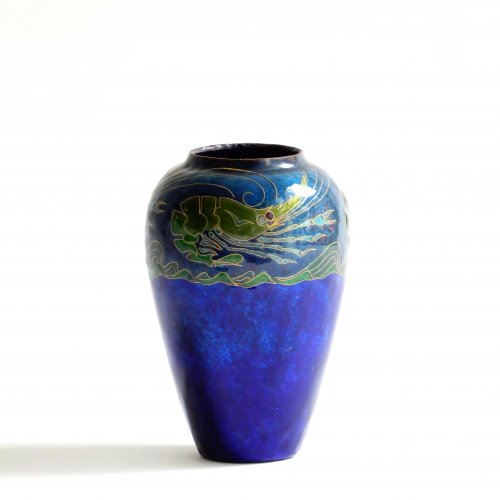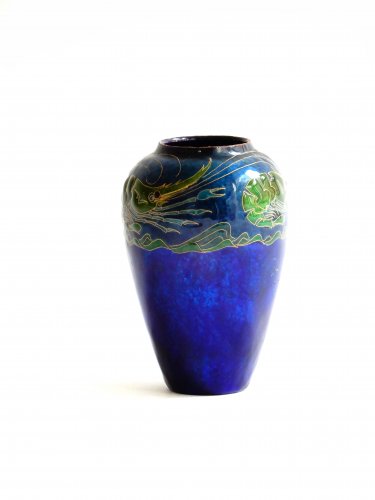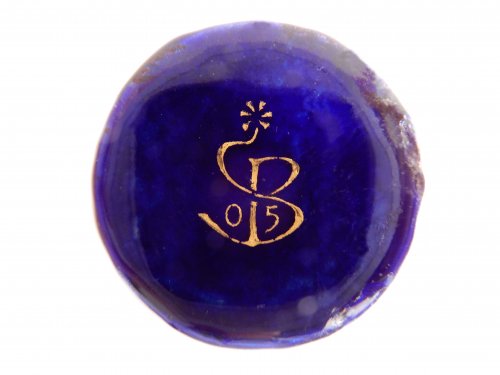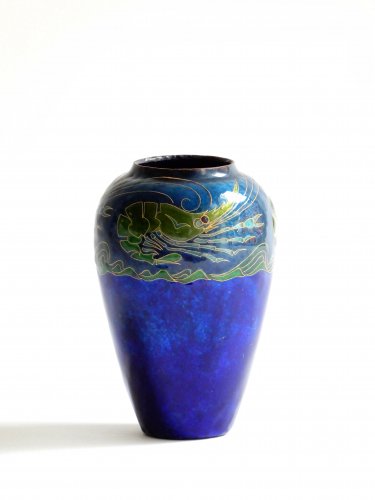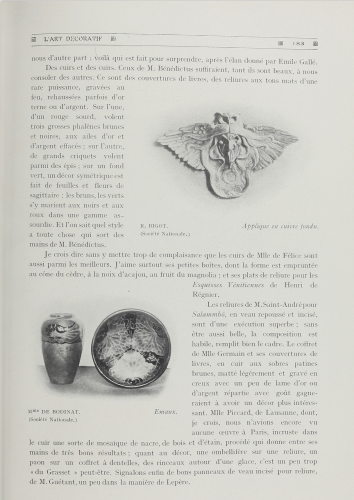Marguerite de Bodinat (Fr. 1864-1960) Enamel cloisonné vase 'Crevettes'
About this piece
Beautiful and very refined enamel little vase by the French artist Marguerite de Bodinat.
This little vase is also exposed at the Paris Salon des Artistes Décorateurs and Salon de la Nationale in 1907. It was her debut on this Salon
This vase 'Crevettes' is also described in an article about the salon in the magazine "l'Art Décoratif", no 104, May 1907. The writers are very enthusiastic about this newcomer, they wrote about her; " Madame de Bodinat, who has mastered the technique of cloisonné enamel to perfection. Her designs are so refined, elegant and her motifs, based on flora and fauna with a symmetrical repetition, so pure and powerful, as well as her use of colour, which is very tasteful."
(Part of he text, free translated).
I can't agree more with this enthusiastic description. The decoration of this vase is refined and stylized, actually very unusual for 1905. The frieze with the three shrimps (crevettes) is so beautifully rendered, the use of colour is also magnificent. Marguerite de Bodinat has depicted the sea, with the intense deep blue, with a slight gradient from blue to a slightly lighter azure blue, with the various green tones of the shrimps next to it and the waves of the sea. The shrimps eyes are dark red, like rubies. The gold thread contrasts beautifully with the intense blue. This vase is like a jewel, it looks precious and is of high quality.
The bottom of the vase is signed in gold, a daisy that winds through the B and the date 05 (1905).
The vase is made of cloisonné enamel, a special and difficult technique in which a flattened wire is fixed on a metal (copper) surface, sometimes a layer of enamel is first applied to which the wire is applied and then heated in an oven so that the wire is secured in the enamel layer. The interstices are then covered with different colours of enamel where the thread prevents the colours from flowing into each other. This creates a beautiful decoration in which the various wires function as lines.
Cloisonné enamel is a very old technique that was already used in Byzantine architecture in the 5th century BC.
Biography:
Biography:
Marguerite de Bodinat, 1864-1960, (maiden name Dubois de Saint-Vincent).
She came from a wealthy family, her father was a magistrate and
president of the civil court. In addition, her father was also
very creative and a creditable musician and painter.
Encouraged by her father, Marguerite had started early on
drawing and painting, and she was very talented.
Her father died however when she was 14 years old and from that time she was raised by her uncle, which was a good enameller. He introduced her to the
art of enamelling and taught her the techniques.
Marguerite was so talented that she was also apprenticed to Jules Brateau and Verneuil (Maurice Pillard).
In the meantime she was also married to Anatole de Bodinat, with whom she had a happy marriage that unfortunately remained childless for them.
Anatole encouraged her in her profession and helped her where he could, so
he often hammered the brass into shape for her. Her speciality was
email-cloisonné.
In 1905 she was introduced by her teacher Verneuil at the
Parisian Salon des Artistes Décorateurs (SAD) and Salon de la Nationale, where she many times made her
work to exhibit. This vase was made in 1905 and exhibited at the
salon in 1907, it was then sold to Madame Raguenet de
Saint Albin.
Literature and sources:
- Alastair Duncan 'The Paris Salons, 1895-1914', Volume V, Objets d'Art & Metalware, p.408.
Antique Collectors Club Limited, Suffolk, 1999. P. 103 (with photo of the vase).
- Gallica - French National Library.
- Magazine "l'Art décoratif", no 104, May 1907, p. 181-183, photo of the vase at page 183.
Geneviève Euverte et François de Bodinat; 'Marguerite de Bodinat, 1864-1960". France.
Condition
Very good.
Material:
Enamel
Measurements:
Height: 9 cm
(3,54")
Year:
1905
Origin:
France
Artist / atelier:
Marguerite de Bodinat (Fr. 1864-1960),
